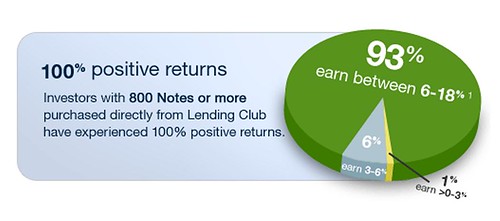 I am always looking for interesting new investments, whether start-ups or completely different asset classes like wine or real estate. Earlier this year I started researching peer to peer (P2P) lending after reading about Kleiner Perkins’ investment in Lending Club, and Mary Meeker (KPCB partner) and John Mack (former Morgan Stanley CEO) joining their board. P2P lending basically means that you can directly lend money to other people. Sites like Lending Club and Prosper.com facilitate this, by putting borrowers in several risk classes and giving you the opportunity to spread your investment over many different borrowers (e.g. if you invest USD 5000 you could lend USD 25 to 200 people).
I am always looking for interesting new investments, whether start-ups or completely different asset classes like wine or real estate. Earlier this year I started researching peer to peer (P2P) lending after reading about Kleiner Perkins’ investment in Lending Club, and Mary Meeker (KPCB partner) and John Mack (former Morgan Stanley CEO) joining their board. P2P lending basically means that you can directly lend money to other people. Sites like Lending Club and Prosper.com facilitate this, by putting borrowers in several risk classes and giving you the opportunity to spread your investment over many different borrowers (e.g. if you invest USD 5000 you could lend USD 25 to 200 people).
When I was reading that returns of around 10% (net) per year are quite normal I thought it sounded too good to be true. Based on my corporate finance background I knew this kind of returns without a huge risk should not be possible in an efficient market. But the fact that some top VCs invested millions of dollars in the company intrigued me. These are smart people, did they see something that I didn’t see?
It took me some time, but I finally figured out that sites like Lending Club are actually giving small investors the same kind of returns that in the past only banks could get. The Internet made this possible, because the bank as a middle man was cut out. Because you diversify among many different borrowers you can estimate the default rate in advance, making the investment much safer than it would be when you would just loan to a couple of people. Returns of 10% on their loan portfolio are nothing special for banks, that’s how they got rich and that’s how they finance their huge overhead.
After talking to some people at Lending Club in June this year I decided to “join the club” and put money into a fund run by Lending Club subsidiary LC Adivsors. The advantage of the fund is that you don’t have to decide which loans to invest in, which is something I don’t have time for (or don’t want to make time for). There is a minimum investment for the fund obviously, but if you want to make P2P investment a significant part of your asset allocation you should certainly look at it.
So far my experience has been exactly what I expected, with net monthly returns over 0.7% per month in my portfolio. Service is excellent, with monthly updates and a contact person that I can get in touch with any time. If you’re interested in the fund feel free to contact me by email (marcvanderchijs (at) gmail (dot) com) and I can put you in touch with my contact person at Lending Club.
Of course you can also invest in loans with much smaller amounts, a lot of people seem to start out with a few thousand USD and add a small amount every month. There are a lot of tools out there to decided which loans to invest in, and which doesn’t need to take a lot of time if you don’t add a lot of $$ every month. There are quite some blogs about P2P lending and on how to get started, check out http://www.lendacademy.com/ for a good overview.
The reasons I decided to write this post now is because Lending Club keeps on growing very fast, and announced earlier this week that the company now has over USD 1 billion in person loans and is cash-flow positive, which is a major thing for a fast growing company. Their funds have about USD 250 million under management. If you are looking for an interesting and high-yield investment you should make sure to take a look at p2p lending. Lending Club and Prosper are disrupting the financial market for loans and I think this might become a big industry with very interesting returns for lenders.

